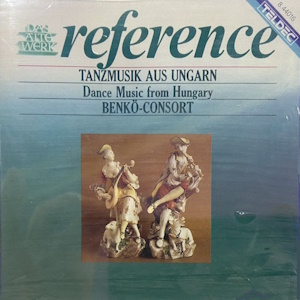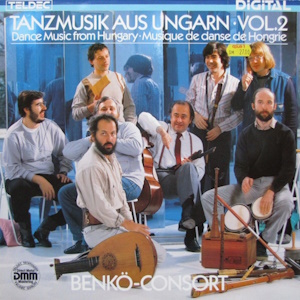 |
| 1 CD -
8.44016 ZS - (C) 1988 |
 |
| 1 LP -
6.43106 AZ - (p) 1985 |
|
TANZMUSIK AUS UNGARN
|
|
|
|
|
|
|
|
|
|
| ANONYMUS |
Ungarische Tänze
I
|
|
5' 58" |
1 |
A1
|
|
- Hayduczky ˇ
Heiducken Dantz ˇ Ein
ungerischer Tantz ˇ Ungerischer
Tantz ˇ ab. lib. ˇ bŕtya ˇ Bethler
Lied ˇ Rubato
|
|
|
|
|
| Anthony HOLBORNE
(gest, 1602) |
Galliard und "The
Honiesuckle" |
|
2' 38" |
2 |
A2
|
| ANONYMUS |
Tänze aus dem
"Vietórisz" - Manuskript |
|
2' 32" |
3 |
A3
|
|
- Langsamer
Tantz ˇ Sprungtantz ˇ |
|
|
|
|
| Valentin BAKFARK
(1507-1576) |
Non
dite mai (Gagliarda) und
Passamezzo |
|
4' 17" |
4 |
A4
|
| ANONYMUS |
Tänze von Hans
Neusiedler |
|
9' 05" |
5 |
A5
|
|
- Fuggerin
Tanz ˇ Ein ser guter hoff tantz
mit durch straiche ˇ Hupff auff
ˇ ein guter welscher tantz ˇ
proportio ˇ Wascha mesa ˇ der
Hupff auff ˇ der Juden tantz ˇ
der Hupff auff
|
|
|
|
|
Michael PRAETORIUS
(1571[2]-1621)
|
Ballet und "La
Volta Italiana" |
|
3' 37" |
6 |
B1
|
| ANONYMUS |
Tänze aus dem
"Löcsei" - Manuskript |
|
5' 22" |
7 |
B2
|
|
- Ex c ˇ Ex F
ˇ Chorea hungarica ˇ Proportio ˇ
Ungarischer Tantz ˇ Ein anderer
ung. Tantz |
|
|
|
|
| Don
Giorgio MAINERIO (1545?-1582) |
Tänze
|
|
2' 51" |
8 |
B3 |
|
- La Billiarda
ˇ Saltarello ˇ Schiazola
Marazola |
|
|
|
|
| M.
PRAETORIUS*/ C. GERUAISE (16.
Jh.) |
Französische
Tänze aus der Sammlung
"Terpsichore" |
|
3' 48" |
9 |
B4 |
|
- Courante* ˇ
Allemande ˇ Branle ˇ Branle de
champagne |
|
|
|
|
| Jacques
MODERNE (Ende 15. Jh. - um 1561) |
Tänze |
|
3' 12" |
10 |
B5 |
|
- Bransle de
bourgoigne ˇ Branle de
bourgoigne ˇ Branle de nouveau ˇ
Branle noveau ˇ Branle de
bourgoigne |
|
|
|
|
| ANONYMUS |
Ungarische
Tänze II |
|
4' 33" |
11 |
B6 |
|
- Bergamasca ˇ
Bergamasca ˇ Polonica ˇ
Proportio ˇ Paikos Tancz ˇ Tancz
ˇ Ötödik Tancz hatodon ˇ Apor
Lazar Tancza ˇ ad. lib. ˇ Apor
Lazar Tancza ˇ Ötödik tancz
hatodon |
|
|
|
|
|
|
|
|
|
| BENKÖ-CONSORT |
|
-
Dániel Benkö, Gitarre,
Gitarra battenta, Laute, Vihuela,
Orpharion, Zitter, Schlaggordon,
Klatschen, Gesang
|
|
| -
György Pászti, Türkische
Pfeife, Doppelpfeife, Panflöte,
Rohrpfeife, Sopranino, Sopran-,
Tenor-, Alt-. Baßblockflöte,
Altkrummhorn, Dudelsack,
Plattenspiel |
|
| -
György Róbert, Türkische
Pfeife, Sopranino, Sopran-,
Tenor-, Alt-. Baßblockflöte,
Chalmei, Renaissancegitarre,
Schlagzeug |
|
| -
Csaba Szijgyártó, Türkische
Pfeife, Altblockflöte, Drehleier,
Geige, Viola da bracchio, Viola da
gamba, Viola, Sopran-, Baßrebek,
Sopran-, Baßfidula, Maultrommel,
Zitter, Gesang |
|
| -
László Czidra, Sopranino,
Sopran-, Alt-, Tenor-,
Baßblockflöte, Sopran,
Altkrummhorn, Klatschen |
|
| -
Gabor Kállai, Sopranino,
Sopran-, Tenor-, Baßblockflöte,
Sopran-, Tenor-, Altkrummhorn,
Klatschen, Altviola da gamba,
Viola, Baßkrummhorn |
|
| -
Szolt Harsányi, Baßblockflöte,
Alt-, Baßdulzian, Baßkrummhorn,
Baß Cornamusa |
|
| -
Béla Zsoldos, Schlagzeug,
Glockenspiel, Klatschen, Gesang |
|
-
Kornél Horváth, Schlagzeug,
Klatschen, Gesang
|
|
|
|
|
|
Luogo
e data di registrazione |
|
- |
|
|
Registrazione:
live / studio |
|
studio |
|
|
Producer /
Engineer |
|
- |
|
|
Prima Edizione
LP |
|
Telefunken
- 6.43106 AZ - (1 LP) - LC 3706 -
durata 49' 12" - (p) 1985 -
Digital |
|
|
Edizione
"Reference" CD
|
|
Tedec
- 8.44016 ZS - (1 CD) - LC 3706 -
durata 49' 12" - (c) 1988 - DDD |
|
|
Cover |
|
"Schäferin
und Schäfer", Porzellan. Modell
von J. Chr. W. Beyer, Ludwigsburg
um 1763. Museum für Kunst und
Gewerbe, Hamburg.
|
|
|
|
|
You were
probably surprised when
you see this record
album! How can there be
hits in the Renaissance?
Because the
"Renaissance" designates
a period in our culture
which for music
comprises about the 16th
century; the term "hit",
on the other hand, is
definitely a product of
the 20th century. are we
talking about
Renaissance music made
into pop? are we playing
gaillards or pavanes in
a bossanova or rock 'n
'roll beat? Not at all!
after so many years of
playing Renaissance
music we wanted to
present on a single
record those pieces
which have grown
especially dear to us,
which audiences have
always liked most, and
which also happen to be
those pieces that were
the most popular in
their own time, as we
can infer from written
records about their
prevalence.
Those of you who like to
listen to Renaissance
music will remember the
Neusiedler family,
Bálint, Bakfark, Jacques
Moderne or Praetorius
and Holborne. And to us
Hungarians, as we always
try to bring a little of
our Eastern European
music to the concert
halls of Europe, the
names of the Löcsei
Codex or the Vietórisz
Codex are just as
familiar. In short, we
would like to present
you with a bouquet of
the most popular musical
pieces, the hits, of the
Renaissance. As far as
our interpretation of
this music is concerned,
we are not trying to be
puristic, to be orthodox
in interpreting the
music's authenticity.
Still we cannot deny who
we are: pople of the
20th century, musicians
who, as opposed to
Renaissance
contemporaries, have
been exposed to later
"stars2 like Bach,
Beethoven and Bartók.
Our ensemble is made up
of musicians with very
different backgrounds:
Béla Zsoldos is a born
jazz musician, but he in
also at home in variety
music, which is probably
evident in his
percussion playing.
Kornél Horváth began as
jazz flutist, but is
really a master of the
congas. László Czidra
used to play oboe in a
symphony orchestra, and
Szolt Harsányi, too,
plays in a symphony,
presently in the
Hungarian Radio Symphony
Orchestra. "Count"
Kállai specializes in
the recorder music of
Bach. György Róbert also
plays the recorder, but
he studied jazz piano at
the Béla Bartók School
of Music as well. György
Pászti and Csaba
Szijgyártó are really
folk musicians; even
though they graduated
from the music academy
they feel most at home
in Hungarian folk music.
And I myself have spent
the past decade
interpreting the works
of Bálint Bakfark, but I
like to play pop just as
much as classical music.
It's not surprising,
then, that an ensemble
such as ours will
interpret the music of
the Renaissance in a
very unique way.
In putting together this
record we coordinated
the A and B sides, but
they can be enjoyed
independently as well,
one side being the
eastern European, the
other the Western
European side. As far as
the Western European
pieces are concerned, we
don't play these too
differently from other
emsebles. The four and
five part dances of
Praetorius, Holborne and
Moderne have become such
standard works of
Renaissance concerts
that we had no intention
of changing their set
forms. We would like to
give you a picture of
Elizabethan English,
French, and Burgundian
court music. Perhaps
only in Praetorius'
music do we add a little
Eastern European touch
by including the panpipe
- which is used today in
pop and folk music, but
also appeared in the
books of Praetorius.
On the border between
Eastern and Western
culture is the music of
the Neusiedlers, the
famous family of lute
players who stem from
the area around Lake
Neusiedler. especially
in the pieces of Hans
are many such elements
which lead us to
conclude that he spent
time in the company of
many different musicians
and people of various
nationalities. He wrote
Gypsy and Jewish dances
and character pieces.
The suite which appears
on this record is
intended to show the art
of Hans Neusiedler from
a different aspect.
Although originally the
pieces were written for
lute. I don't think we
commited too much of a
transgression by playing
these intervals in their
four and five voice
form. The vice versa has
occured quite often, for
example in the works of
Suzato, Phalčse, or
Attaignant which were
published in several
voices and have then
surfaced in numerous
lute variations all over
Europe. The same is true
for French Madrigals and
chansons which are
popular lute pieces
today. Furthermore, lute
pieces are often
orchestrated to be
performed by whole
orchestras. The
Neusiedler dances
contain oriental Eastern
European elements, as
well; here we tried to
follow in our
interpretation the mood
of the solo lute pieces.
The truly Eastern
European and especially
Hungarian dances are, I
thinks, the least
familiar to European
listeners. How and where
can these be found? In
the 16th century they
were familiar to the
Western European
audiences, but were
considered curiosities
even then. Heckel has
"Ungarische" dances,
Jolin in Strassbourg
wrote a "Passamezo
ungarum", Phalčse
composed "Almand de
Ungrie", and a Polish
manuscript of Dluyovaj
contains a "Hajdu" or
soldier's dance - these
are so-called Hungaried
dances. They can be
brouped into three
categories and their
variations appeared
later in Dutch, Italian,
Polish and German
sources. These are the
dances that were
familiar to Western
Europeans at that time.
In contrast stand the
Löcsei and the Victórisz
Codices, whose equally
outstanding pieces were
almost inaccessible so
far. Now, for the first
time, they are recorded
here in the manner they
were played in the
16th-17th centuries. -
This ist the first time
I have mentioned the
17th century! It is
true, Hungarian
Renaissance music was
some 100-150 years late,
and the two above
mentioned codices are
from the 1680s. Still
the music's thythm and
melody line is more
Renaissance than
baroque. The reason for
the delay was the
extensive Turkish
occupation of Hungary,
which, along with the
other, Slovakian,
Romanian, German and
Polish influences left
their mark on music. It
is thus not surprising
that this record
contains the music of
instruments like the
Turkish pipe, Eastern
European drums or the
panpipe, just as such
characteriastically
Hungarian "folk"
instruments as the
cittern, the "nyenyere"
(a hurdy-gurdy
resembling the Hungarian
bagpipe) or percussion
instruments like the
"köesögduda" (jugpipe)
and the "láncosbot"
(stick with chains).
Have we actually
combined folk music, pop
music and so-called
classical music, the
music of the classical
Renaissance? For some
ten years we have
brooded over this
question: in which
category should we place
Renaissance music,
especially its Eastern
European branch? We can
consider it dance music,
because it was intended
to be played for dancing
(except for the pieces
which were not intended
for ritualistic purposes
or are not polyphonic
phantasies). And it is
also folk music since
most of the recorded
melodies survived in the
folk music of Hungary;
and I think of Europe,
too. Phalčse, for
example, included folk
music in his collection,
but after 400 years
these pieces are today
considered classics.
Because they are
associated with éhalčse,
they are considered
"art", though they stem
from folk sources. So we
have no definite, final
answer to our question,
we are merely offering
this record to every
listener, every
Renaissance lover, and
hope that everyone will
find something he likes:
folk music, dance music,
classical music...
And one important
composer I have on
pourpose left to the
end: Bálint Bakfark, who
was born in Hungary, but
was famous in Europe,
even in the world. Here
he is not represented
with his phantasy (which
can be heard on another
TELDEC recording), but
with his dances,
including a dance which
he didn't himself
compose but which was
made in his honor.
Daniel
Benkö
|
|